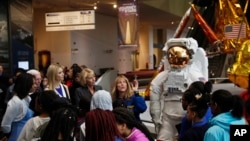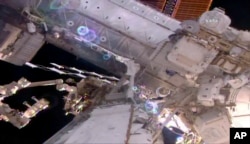The deputy commander of the U.S. Strategic Command is calling for the development of a code of conduct for space as dreams of altruistic exploration fade.
Vice Admiral Charles Richard believes establishing norms and practices of behavior in space would help nations better understand each other's activities.
"We're still sorting out what constitutes an attack in space," Richard said at a conference titled "Space Security: Issues for the New U.S. Administration" held last week at the Center for Strategic and International Studies in Washington.
“What is the indisputable evidence required within the international community to assert violation of sovereign territory in space? What constitutes provocation in space from our point of view?” he asked.
No rules of engagement in space
Conducting exercises with U.S. partners and allies has revealed the difficulty of answering those questions because there are no rules of engagement for space, said Richard.
While acknowledging that "space is different," said Richard, "Some of the questions we are answering have already been answered in the maritime domain and in the air domain so we have precedent to start from."
For decades, the roadmap for the arena was the Outer Space Treaty of 1967 signed by Russia and the United States during the Cold War, which has now been signed by 105 nations and signed but not ratified by 24 more.
The agreement bans placing nuclear weapons or weapons of mass destruction in Earth orbit, on the moon or on any other celestial real estate. It further forbids, “the establishment of military bases, installations and fortifications, the testing of any type of weapons and the conduct of military maneuvers on celestial bodies shall be forbidden.”
Over 1,400 satellites orbiting Earth
There are loopholes in the treaty's language. It did not prohibit the use of conventional weapons or ban military forces from space as long as they undertook non-aggressive activities, such as scientific research or launching satellites for spying and communications. (As of July 2016, there were 1,419 satellites orbiting Earth, about 350 of them for military use, according to the Union of Concerned Scientists, which maintains a database.)
The wake-up call came in 2007 when China shot down an aging Fengyun-1C weather satellite while testing an anti-satellite (ASAT) device mounted on a ballistic missile. The test shattered the satellite into more than 2,000 pieces and, for many, solidified the notion of space as a theater of war.
In 2015, the U.S.-China Economic and Security Review Commission called for more study of China's counterspace program in its annual report to Congress. On March 22, an official from the U.S. Strategic Command told VOA that the U.S. military and China have had several dialogues on space security and hoped that the dialogue would continue.
Safe, stable and secure
Peter Hays, a professor of space policy at the U.S. Department of Defense and a professor of space policy at the George Washington University Institute of Space Policy, said at the March 22 conference that the U.S. should not be the first country to deploy weapons to space, but it should be prepared.
Richard said that while the U.S. would never want to extend war into space, the question today is "How do we deter our adversaries in space while keeping it safe, stable and secure? … Whether you're guiding ships, jets, drones or missiles, space is the domain that enables all others.
“If we have an agreed-to set of norms and behaviors, now you start to minimize the chance of miscommunication,” he said, adding that minimizing the chances of misinterpretation also reduced the likelihood of “an inappropriate or disproportionate response.”
Libo Liu contributed to this report which originated in the VOA Mandarin Service.









